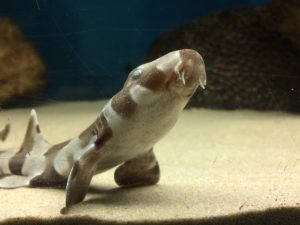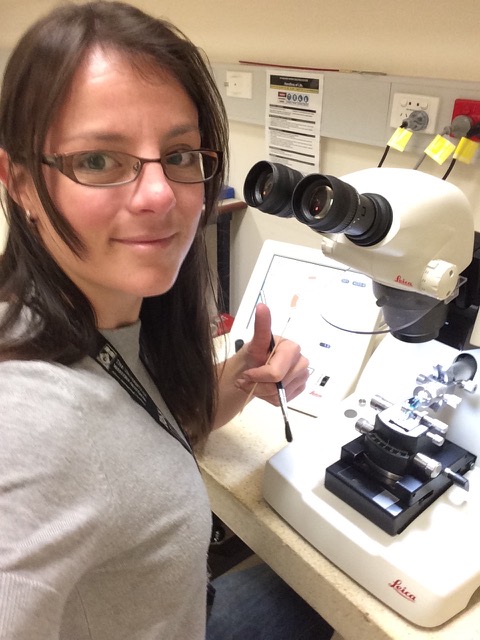Victoria Camilieri-Asch, BSc (Hons I)
Why my research is important
This research will not only further our understanding of how sensitive ancient fishes like sharks are to olfactory stimuli, compared to other fishes, but also how this sensory system has evolved in early vertebrates. The detection and sensitivity to environmental signals determines the success of each species within its ecological niche. Neuroanatomical approaches provide important indicators of sensory sensitivity and behaviour, which can help to explain the functional significance of individual sensory modalities. Relative brain size has proven to be the most robust paradigm of brain evolution, but this measure is presently based on relative brain volume, not the absolute number of neurons in the brain or its major subdivisions. The quantification of neuronal inputs is most needed data to further our understanding of the evolution of the vertebrate brain. In particularly, how early vertebrates such as elasmobranchs (sharks, skates and rays) prioritize their sensory abilities with respect to their ecological niche, to identify the selection pressures acting on the evolution of the brain.
Better understanding olfactory-driven behaviours in sharks will ultimately help to better instruct conservation efforts, guide management practises, and thus preserve natural behaviours in vulnerable or threatened shark species.


Professional memberships
Australian Microscopy and Microanalysis Society (AMMS) -student member since February 2018
International Society for Neuroethology (ISN) - student member since February 2017
Australasian Society for the Study of Animal Behaviour (ASSAB) - student member since February 2017
American Elasmobranch Society (AES) - student member since July 2016
Australasian Association for ChemoSensory Science (AACSS) - student member since May 2016
Australia Marine Sciences Association (AMSA) - student member since March 2016
Australia Society for Fish Biology (ASFB) - student member since March 2016
Oceania Chondrichthyan Society (OCS) - student member since February 2011
Victoria completed her BSc with an Honours degree in Marine Sciences at The University of Queensland in 2011, focusing on behavioural responses of elasmobranchs to anthropogenic electromagnetic fields. She is now a PhD student at The University of Western Australia undertaking research on olfactory abilities in elasmobranchs compared to teleosts.
Thesis
Neurobiological indicators of olfactory sensitivity: a comparative study between a bony and a cartilaginous fish
Summary
Chemoreception, an important sensory modality in vertebrates, can be broadly split into olfaction (sense of smell) and gustation (sense of taste). Limited knowledge is available on the chemosense of fish compared to higher vertebrates, and particularly cartilaginous fishes (Class Chondrichthyes, divided into two sub-classes; sharks, skates and rays (Elasmobranchii) and chimaeras (Holocephali)), which collectively represent the earliest jawed vertebrates. There is currently a need for a detailed study of olfactory pathways and detection thresholds to assess the sensitivity and the relative importance of olfaction in elasmobranchs. This research aims to quantitatively assess the olfactory inputs to the central nervous system (CNS), i.e. primary inputs to the olfactory bulbs and secondary inputs to the telencephalon, as a more accurate indicator of olfactory sensitivity. The research focuses mainly on two model species – a bony fish and a cartilaginous fish – to compare and test whether sharks are effectively more sensitive to olfactory stimuli than other fishes. The number of first order and second order olfactory neurons are quantified using Transmission Electron Microscopy (TEM), and the convergence ratio (anatomical proxy for sensitivity from the peripheral to the central nervous system) subsequently calculated and compared to the relative size of the olfactory bulbs (the gross measure/proxy of sensitivity currently used), using X-Ray Microscopy (XRM). The morphology, abundance and distribution of the different types of olfactory receptor neurons within the olfactory epithelium lining the olfactory cavities are characterized using Light Microscopy (LM), Scanning Electron Microscopy (SEM) and immunohistochemistry (IHC). A computational study of the hydrodynamics in the olfactory cavities of both study species is underway to further understand morphological implications for olfactory capabilities. Ultimately, the objective is to better understand the neuroanatomical evolution of the olfactory system in early vertebrates and to investigate the neural basis of olfactory-driven behaviours in sharks.
Publications
Camilieri-Asch V, Kempster RM, Collin SP, Johnstone R and Theiss SM. 2013. A comparison of the electrosensory morphology of a euryhaline and marine stingray. Zoology, 116(2013):270–276
Lisney T, Yopak KE, Camilieri-Asch V, Collin SP. 2017. Ontogenetic shifts in the neural organization of the central nervous system of a stingray, Neotrygon kuhlii. Brain, Behavior and Evolution, DOI: 10.1159/000455223
Funding
- Australian Government Research Training Program (RTP) International Fee Offset Scholarship
- The University of Western Australia Safety Net Top-Up Scholarship
- UWA Graduate Research School and School of Biological Sciences research and travel funds
- Postgraduate Student Association Data Collection and Travel Awards
- Ada Jackson Irwin Street Commemoration Award
